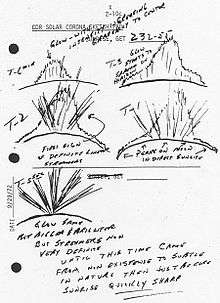Atmosphere of the Moon
The atmosphere of the Moon is a very scant presence of gases surrounding the Moon. For most practical purposes, the Moon is considered to be surrounded by vacuum. The elevated presence of atomic and molecular particles in its vicinity compared to interplanetary medium, referred to as "lunar atmosphere" for scientific objectives, is negligible in comparison with the gaseous envelopes surrounding Earth and most planets of the Solar System. The pressure of this small mass is around 3×10−15 atm (0.3 nPa), varying throughout the day, and in total weighs less than 10 metric tonnes.[2][3] Otherwise, the Moon is considered not to have an atmosphere because it cannot absorb measurable quantities of radiation, does not appear layered or self-circulating, and requires constant replenishment due to the high rate at which its gases are lost to space.
Sources
One source of the lunar atmosphere is outgassing the release of gases such as radon and helium resulting from radioactive decay within the crust and mantle. Another important source is the bombardment of the lunar surface by micrometeorites, the solar wind, and sunlight, in a process known as sputtering.[4]
Losses
Gases can either:
- be re-implanted into the regolith as a result of the Moon's gravity;
- escape the Moon entirely if the particle is moving at or above the lunar escape velocity of 2.38 km/s (1.48 mi/s);
- be lost to space either by solar radiation pressure or, if the gases are ionized, by being swept away in the solar wind's magnetic field.
Composition
What little atmosphere the Moon has consists of some unusual gases, including sodium and potassium, which are not found in the atmospheres of Earth, Mars, or Venus. At sea level on Earth, each cubic centimeter of the atmosphere contains approximately 1019 molecules; by comparison the lunar atmosphere contains fewer than 106 molecules in the same volume. On Earth, this is considered to be a very good vacuum. In fact, the density of the atmosphere at the Moon's surface is comparable to the density of the outermost fringes of Earth's atmosphere, where the International Space Station orbits.[5]
The elements sodium and potassium have been detected in the Moon's atmosphere using Earth-based spectroscopic methods, whereas the isotopes radon-222 and polonium-210 have been inferred from data obtained by the Lunar Prospector alpha particle spectrometer.[6] Argon-40, helium-4, oxygen and/or methane (CH
4), nitrogen (N
2) and/or carbon monoxide (CO), and carbon dioxide (CO
2)) were detected by in-situ detectors placed by the Apollo astronauts.[7]
The average daytime abundances of the elements known to be present in the lunar atmosphere, in atoms per cubic centimeter, are as follows:
- Argon: 20,000–100,000[8]
- Helium: 5,000–30,000[8]
- Neon: up to 20,000[8][9]
- Sodium: 70
- Potassium: 17
- Hydrogen: fewer than 17
This yields approximately 80,000 total atoms per cubic centimeter, marginally higher than the quantity posited to exist in the atmosphere of Mercury.[7] While this greatly exceeds the density of the solar wind, which is usually on the order of just a few protons per cubic centimeter, it is virtually a vacuum in comparison with the atmosphere of the Earth.
The Moon may also have a tenuous "atmosphere" of electrostatically-levitated dust. See Moon dust for more details.
See also
- Atmosphere of Mercury
- Exosphere
- Lunar Atmosphere and Dust Environment Explorer (LADEE)
- Orders of magnitude (pressure)
- Sodium tail of the Moon
References
- ↑ Bell, Trudy E.; Phillips, Tony (7 December 2005). "Moon Storms". NASA.
- ↑ Williams, David R. "Moon Fact Sheet". NASA. Retrieved 16 November 2016.
- ↑ Globus, Ruth (1977). "Chapter 5, Appendix J: Impact Upon Lunar Atmosphere". In Johnson, Richard D.; Holbrow, Charles. Space Settlements: A Design Study. NASA. NASA SP-413.
- ↑ Lucey, Paul; Korotev, Randy L.; Gillis, Jeffrey J.; Taylor, Larry A.; Lawrence, David; et al. (January 2006). "Understanding the Lunar Surface and Space-Moon Interactions". Reviews in Mineralogy and Geochemistry. 60 (1): 83–219. doi:10.2138/rmg.2006.60.2.
- ↑ "Is There an Atmosphere on the Moon?". NASA. 12 April 2013.
- ↑ Lawson, Stefanie L.; Feldman, William C.; Lawrence, David J.; Moore, Kurt R.; Elphic, Richard C.; et al. (September 2005). "Recent outgassing from the lunar surface: The Lunar Prospector Alpha Particle Spectrometer". Journal of Geophysical Research. 110 (E9). Bibcode:2005JGRE..110.9009L. doi:10.1029/2005JE002433.
- 1 2 Stern, S. Alan (1999). "The lunar atmosphere: History, status, current problems, and context". Reviews of Geophysics. 37 (4): 453–491. Bibcode:1999RvGeo..37..453S. doi:10.1029/1999RG900005.
- 1 2 3 Benna, M.; Mahaffy, P. R.; Halekas, J. S.; Elphic, R. C.; Delory, G. T. (May 2015). "Variability of helium, neon, and argon in the lunar exosphere as observed by the LADEE NMS instrument". Geophysical Research Letters. 42 (10): 3723–3729. Bibcode:2015GeoRL..42.3723B. doi:10.1002/2015GL064120.
Neon was detected over the nightside at levels comparable to He and was found to exhibit the spatial distribution of a surface accommodated noncondensable gas.
- ↑ Steigerwald, William A. (17 August 2015). "NASA's LADEE Spacecraft Finds Neon in Lunar Atmosphere". NASA. Retrieved 18 August 2015.
![]() This article incorporates public domain material from the National Aeronautics and Space Administration document "Is There an Atmosphere on the Moon?".
This article incorporates public domain material from the National Aeronautics and Space Administration document "Is There an Atmosphere on the Moon?".


